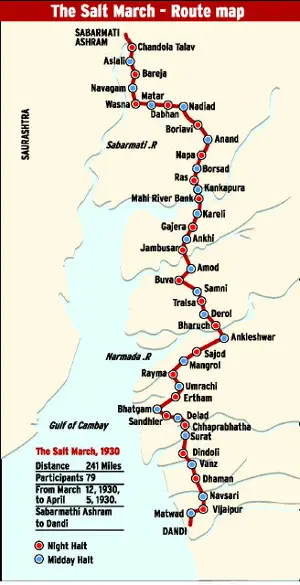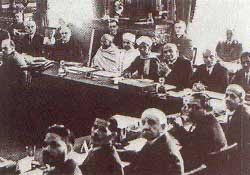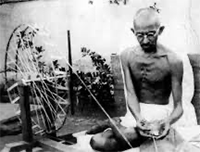Mohandas Gandhi: Independent India's Guiding Light
Part 2: A Life's Work Also in 1930 occurred the Salt March, perhaps Gandhi's most famous set of events. Gandhi, looking to emphasize a policy of civil disobedience, disdained violence in his pursuit to expose what he and others saw as unfair treatment. In this particular case, the protesters were taking issue with a tax on salt. The Raj had passed a series of laws the net effect of which was that Indians could not make or sell salt but, instead, had to buy it from Britain, which placed a high tax on it. Poor people certainly couldn't afford to pay the tax, and people who had more money didn't appreciate the high tax or the British monopoly. Yet salt was a necessary element of the diet of people who lived in hot, steamy India; and gathering and producing salt was something that Indians had done themselves for many, many years. 
Gandhi set out from his religious retreat at Sabermati with a few dozen fellow marchers. As they passed through various villages on their way to the sea, they would stop and address gathered crowds; when the march resumed, the number of marchers had increased. By the time that Gandhi and company reached the town of Dandi, on the Arabian Sea coast, the number of marchers was in the hundreds. The entire journey was 240 miles; close to 80 people made the entire journey. On April 6, the protesters picked up salt by the handfuls from the shore. Technically, they were breaking the law; they were not, however arrested. Gandhi urged a continuance of the protest against the salt tax by committing other acts of civil disobedience. The Raj responded by arresting and imprisoned thousands of protesters. Lord Irwin, the British viceroy, ordered Gandhi arrested when the protest leader said that he would march on a saltworks at Dharasana on May 21. That protest went ahead without Gandhi; police responded to the peaceful protest of 2,000 or so by attacking and administering beatings. Nonetheless, an estimated 80,000 people took part in the salt protest. These beatings made their way into the international news, and the British didn't look so civilized after all. This had a galvanizing effect, both in India and in Britain. Indians by the thousands joined the nonviolence movement – the movement to rid India of Britain once and for all. Gandhi was held for some time but was released in January 1931. Later that year, he was summoned to the U.K. He met with Viceroy Lord Irwin, and an agreement between the two, known as the Gandhi-Irwin Pact, came about on March 5. Among the promises made by the U.K.:

Gandhi went to London a year later to participate in two Round Table conferences, to try to resolve the issues once and for all. He found the U.K. representatives to be retrenching a bit and so started another satyagraha campaign. Still wanting to keep the peace as much possible, the U.K. introduced the Government of India Act 1935, which featured:
Meanwhile, the Anti-India Muslim League (AIML), begun in 1906 and guided by Muhammad Ali Jinnah, was still campaigning to remove the British Empire from the leadership of India. The 1940 Lahore Resolution called for an India free from U.K. rule and also for a part of that U.K.-free India to be free from Hindus–in other words, a home for Muslim Indians. Britain didn't want this, and Gandhi didn't, either, but Jinnah and the AIML did want this and they had large numbers by this point. They also saw that the INC had weakened the U.K. grip on India and saw an opportunity to push their ideas. Gandhi urged Indians not to fight in World War II, but he was very much in the minority. He kept up his campaign to convince the U.K. to leave India altogether. In 1942, he gave a speech in Mumbai titled "Quit India"; that became the name of the movement. 
U.K. authorities responded by arresting the 73-year-old Gandhi, who languished in prison for two years, during which time his wife was also imprisoned, where she died. Gandhi himself contracted malaria and narrowly avoided death. He was released in 1944. Jinnah had kept the Quit India movement front and center while Gandhi was in prison, and the two men met several times when Gandhi was released. Gandhi was still firmly against separate states based on religion, but he lost that battle in the end. A large series of sectarian struggles turned violent in 1946, accentuating the arguments of Jinnah and others that living space should be granted according to religious belief. 
On Aug. 15, 1947, India won its independence from Britain. The caveat was that the subcontinent split into two countries, India and Pakistan. This was known as the Partition. Gandhi spent the day spinning on his spinning wheel and urging a peaceful transition. The very next year was Gandhi's last. He had made a handful of enemies in his year in the public eye. One of them was a young man who shot him dead in January 1948. Gandhi, the world's foremost proponent of nonviolence, died at the hands of a gunman. Next page > A Life's Work > Page 1, 2
|
|
Social Studies for Kids
copyright 2002–2026
David White




